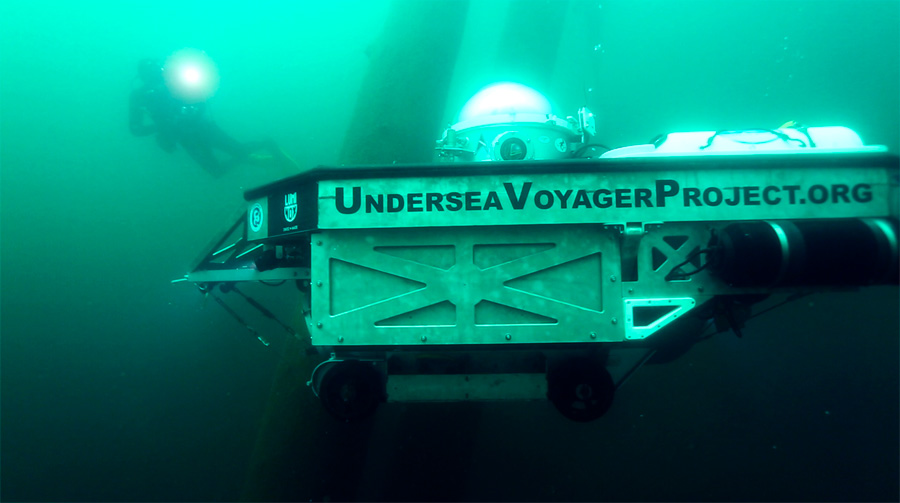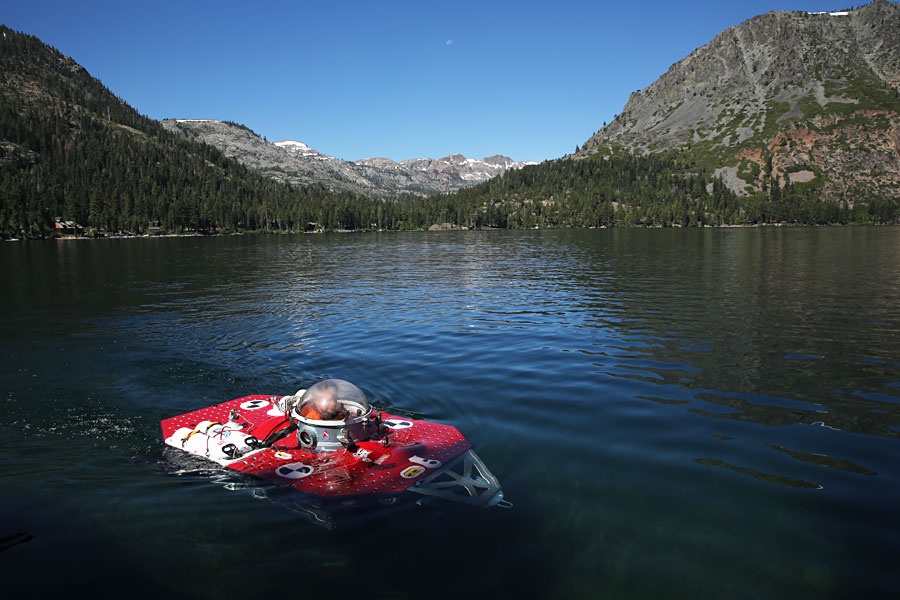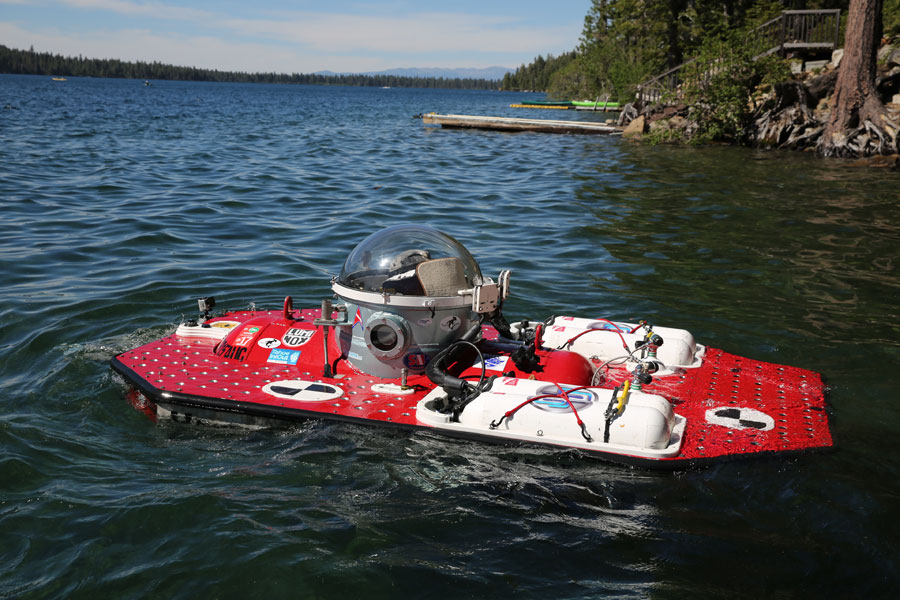High up in the Sierra, one mile south of Lake Tahoe, lies one of California’s most unique and beautiful alpine lakes. At 6,300 feet in elevation, Fallen Leaf Lake was carved out of granite by two massive glaciers that traveled northward down the Glen Alpine Valley, leaving behind a lake that is now 3 miles long, just under a mile wide, and 410 feet deep at its deepest point.
Protected from runoff and commercial development, its clear, cold water is home to Lahontan cutthroat trout (the only trout species native to Fallen Leaf Lake) and dozens of ancient trees, many still standing upright. There are 96 trees found so far, standing up to 77 feet tall, with some fallen trees measuring over 100 feet in length. Carbon dating tests have shown that some of these trees lived between the 9th and 12th centuries, and at least three older trees have been dated to between 18 and 35 centuries ago. Like nearby Lake Tahoe, much of the deep lake bed still remains unseen by any humans.
In 1997, some researchers who studied the trees came to the conclusion that the submerged ancient mature conifer trees grew during a medieval megadrought that lasted 150-200 years. Once the drought was over, the lake level quickly rose 150-200 feet, they theorized, quickly submerged the trees and preserved them in the frigid water that hovers just above freezing.
That theory doesn’t seem right according to some, including Tom Loomis, a third-generation resident and avid outdoorsman. Tom owns a cabin on Fallen Leaf Lake, grew up hiking and snowmobiling the mountains around it, and has spent decades scuba diving in the waters below it. Based on evidence seen in the local terrain and found underwater during hundreds of dives on the ancient trees, he believes there’s a completely different answer.
“The theory that the trees grew there during a megadrought sounds good on paper, but the evidence just doesn’t add up”, Tom explains. “I’ve been diving on these ancient trees for decades and from what I’ve seen firsthand, it’s obvious that there is a different explanation.”
This summer, Tom is out to prove what he believes really happened, with the help of citizen scientists and the Undersea Voyager Project, a non-profit organization located in Napa, California. Through dozens of scuba dives and dives in the Undersea Voyager Project’s 2-person submarine, they are collecting almost certain proof that their theory best describes how the trees got to the bottom of Fallen Leaf Lake.
An Alpine Beauty
Fallen Leaf Lake is located just 1.3 miles south of Lake Tahoe. The lake is 152 feet higher in elevation and separated from its larger cousin by a terminal moraine that is visible at the north end of the lake, where the receding glacier that formed the lake ended its run and deposited its debris. If the glacier had continued instead of stopping, Fallen Leaf Lake would be a bay similar to nearby Emerald Bay, which is located just 3 miles north of Fallen Leaf Lake.
The water in Fallen Leaf is clear and potable, and visibility underwater averages 40 feet. Through underground springs and Glen Alpine Creek at its southern end, the water in the lake is naturally exchanged every eight years, compared to the much deeper Lake Tahoe which exchanges its water every 700 years. Like its larger cousin to the north, Fallen Leaf Lake doesn’t freeze over in the winter, but its water temperature at depth is very cold, hovering at 39 degrees below the thermocline – the temperature at which water is most dense. In winter, the surface temperatures can hover just a few degrees above freezing.
Due to its surface elevation of 6,377 feet, scuba diving here is complicated with reduced dive times, slower ascent rates, and an increased risk of decompression sickness. Diving here does require specialized knowledge in altitude diving along with cold-water gear. There is also very limited dive support in the area – the nearest dive shop, Sierra Diving Center in Carson City, is more than an hour’s drive away. It’s the closest place to get air fills. Northern Nevada Hyperbarics is at Renown Medical Center in Reno, Nevada should any accidents requiring recompression occur.
The land surrounding Fallen Leaf Lake is surrounded by homes and cabins, small and large, and leased from the U.S. Forest Service, a part of the Lake Tahoe Basin Management Unit. The tiny community of Fallen Leaf at the south end has a general store, post office, and a small marina with boats for rent. The town of South Lake Tahoe is just 6 miles away to the north.
Signs of a Megadrought
The origin of the 100-foot tall trees still standing in Fallen Leaf Lake has been investigated and debated before, including a study by researchers at the University of Nevada, Reno. Their surveys led them to the conclusion that the medieval trees in the lake grew there during a severe drought during the mid- and late-Holocene period, maturing while the lake level was 130 to 200 feet below its modern elevation. The team, led by John Kleppe, published a paper on their findings and presented them in seminars.
In contrast to the current mission by the Undersea Voyager Project, the study by Kleppe was funded by grant money from the University of Nevada, Reno. The latest mission by the Undersea Voyager Project is being done by local residents with generations of knowledge of region, explorer Scott Cassell, and a team of volunteer citizen scientists.
Kleppe noted in his findings that the ancient trees and lower water levels could be a part of a cycle that may repeat as the climate changes in the future. Although the ancient cycle of megadroughts seem to occur every 650 to 1150 years (and the last one was 750 years ago), it is uncertain when the next one will occur. Many scientists believe that carbon dioxide increasing in the atmosphere may affect, and perhaps intensify, this cycle.
While climate change and drought was assumed to have been the answer as to why ancient trees are still standing upright on the bottom of Fallen Leaf Lake, based on the evidence found and documented in the lake by the Undersea Voyager Project during expeditions this summer, a much different conclusion has been reached – and it has nothing to do with rising and falling water levels.

The Undersea Voyager Project’s submarine “Spots” navigates around at the ancient trees during descent.
An Earthquake Connection
Five faults make up the Tahoe-Sierra Frontal Fault Zone which lies between the Sierra Nevada and the west side of Lake Tahoe; three potentially dangerous fault lines also run deep under Lake Tahoe. The faults have not produced any major earthquakes since people have been living in the region, but that doesn’t mean they haven’t in the past.
Surprising to some, the Tahoe Basin wasn’t formed by glaciers. It was formed when seismic thrusting triggered a dramatic land collapse on the eastern (Nevada) side of the Sierra uplift. Lava from the Mt. Pluto volcano in the Northstar ski area sealed off the basin’s northern end, and eventually the deep crevasse filled with water, becoming what we know now as Lake Tahoe. These continuing seismic events are what may have caused the trees to end up at the bottom of Fallen Leaf Lake, and that’s what the dives on Fallen Leaf Lake this summer have concluded – that instead of growing there, the trees actually slid into the lake from the exceptionally steep terrain directly above it. A close inspection of the terrain directly above the submerged trees also supports this conclusion.
Another interesting fact, supported by previous research and missions to the lake, is that the different trees submerged in Fallen Leaf Lake are not all the same age – or even close. Trees standing side by side, in some cases, vary in age by several thousand years, yet all appear to be in the same pristine condition. If the water level in the lake dropped and allowed the trees to grow there during an ancient drought, how did trees of varying ages end up standing in the same areas? If the water level dropped and allowed some trees to grow in place, then rose, submerging those trees, then dropped again, the oldest trees should show significant deterioration after dying and being exposed to the air for centuries. That’s clearly not the case here. Trees deposited by successive landslides over thousands of years would answer this, however.
The trees themselves also reveal one other interesting characteristic: their bases do not have any roots radiating from them. Instead, they are sitting on the bottom of the lake, weighted by their rock-encrusted root balls, and their roots sheared off within a few feet of their trunks. The roots were torn off before they ended up on the bottom of the lake after rolling and tumbling off the rocky cliffs above. In contrast, dead trees at the shoreline and at other areas above Tahoe that have large roots that radiate hundreds of feet.
Above: The base of an 80 foot tall ancient tree, showing roots torn off in an ancient landslide. (Click to play)
Even with their ancient history, the trees are almost perfectly preserved and rise up to 100 feet above the bottom of the lake. Centuries after their fall, it’s been reported that fresh sap can still be smelled when samples are brought to the surface (to help preserve them, the trees were untouched during the Undersea Voyager missions). Although waterlogged after centuries underwater, the trees’ buoyancy helps hold them upright, with the root ball acting as a weighted anchor.
Sub-humans at the bottom of the lake
With Fallen Leaf Lake over 400+ feet deep and the complications of spending time at any at depth, scuba divers have a very limited dive time to survey and document their findings. This is where the Undersea Voyager Project comes in. Using their one-atmosphere, 2-man submarine (nicknamed “Spots”, after a great white shark Scott dove with for 20 years and was later killed for her fins in Baja), Captain Scott Cassell and the Undersea Voyager Project team is diving the lake this summer to document specific data that so far has proven the theory that the trees actually slid into the lake.
Spots is a unique, one-of-a-kind submarine that can support 1 or 2 occupants to depths of up to 400 feet, which is (conveniently) the maximum depth of Fallen Leaf Lake. Powered by two powerful rear thrusters and two vertical thrusters, she can stay underwater for up to 10 hours. Breathable air is supplied by on-board scuba and oxygen tanks, with a custom-built CO2 scrubber and additional electronic systems to monitor depth, power, lighting, navigation, and life support systems.
An ongoing mission
Scott Cassell and his team at the Undersea Voyager Project are planning to continue their missions at Fallen Leaf Lake to both explore the lake and find further evidence of the landslides which deposited the ancient trees at the bottom of the lake. There are also a few more things that Scott has found that have proven interesting.
“Back in the 1800s, there were no community landfills or recycling facilities”, says Scott. “Instead, local residents and businesses loaded all of their trash onto boats and dumped it into the lake. Because the water is so cold and there is less dissolved oxygen in the water, bacteria doesn’t thrive and decomposition is very slow. We’ve found some shoes and other artifacts from the turn of the century that look like they were lost yesterday.”
To be clear, Scott Cassell and his Undersea Voyager Project didn’t set out to prove prior studies wrong, but rather add more information to both the public and scientific community.
“All exploration, scientific studies and research should welcome new information, evidence, and viewpoints that may support the prevailing conclusion, question it, or offer entirely different conclusion”, Scott Explains. “The goal of our missions at Fallen Leaf Lake this summer is to examine the evidence, examine a different theory that’s out there, and provide more data to the scientific community and public. All of the information gathered on our dives is open and available to the public at any time.” In answer to the question regarding megadroughts in centuries past, Scott says, “There’s no doubt megadroughts have occurred in the past and that the lake level at Fallen Leaf Lake has dropped and risen many times. We’re simply examining whether or not the trees grew there during one of those megadroughts or if these particular trees got there in some other way. So far, all of our evidence on the ancient trees supports the theory that they did not grow there.”
From their research and dives so far, all of the information that the Undersea Voyager Project has discovered does in fact appear to support the theory that the ancient trees at the bottom of Fallen Leaf Lake actually grew on the nearly vertical mountainside above the lake and slid down it in repeated landslides over the centuries. They still stand upright today, anchored at the bottom by their rock-encrusted root balls, in hundreds of feet of clear, fresh, alpine water.
_________________________________________________
Words and photos by Chris Constantine, California Diver Magazine
Sources & further reading:
An Underwater Forest Reveals the Story of a Historic Megadrought
Duration and severity of Medieval drought in the Lake Tahoe Basin
Fallen Leaf Lake’s Underwater Forest
Lake Tahoe: Inside an Underwater Forest Frozen in Time
Fallen Leaf Lake (Wikipedia)
Sierra Diving Center
Fallen Leaf Lake Campground
The Undersea Voyager Project


